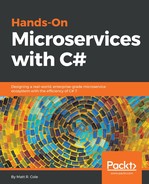Let's start by taking the simplest of all possible scenarios. We have a single producer, which sends one or more messages (each message is one red block) to a single consumer, such as in the following:

Our next step up the difficulty ladder would be to have a single producer publish one or more messages to multiple consumers, such as in the following diagram. This is distributing tasks (work) among different workers, also sometimes referred to as the competing consumers pattern. This means that each consumer will take one or more messages. Depending upon how the message queues are set up, the consumers may each receive a copy of every message, or alternate in their reception based upon availability. So, in one scenario, consumer one may take ten messages, consumer two may take five, then consumer one takes another ten. Alternatively, the messages that consumer one takes, consumer two does not get and vice versa:

Next, we have the ever so famous publish/subscribe paradigm, where messages are sent to various consumers at once. Each consumer will get a copy of the message, unlike the scenario shown previously where consumers may have to compete for each message:

Our next scenario provides us with the ability for a client to selectively decide which message(s) they are interested in, and only receive those. Using a direct exchange, the consumers are able to ask for the type of message that they wish to receive:

If we were to expand this direct exchange map out a little bit, here's what our system might look like:

A direct exchange delivers messages to queues based on a message routing key. The routing key is a message attribute added into the message header by the producer. The routing key can be seen as an address that the exchange is using to decide how to route the message. A message goes to the queue(s) whose binding key exactly matches the routing key of the message.
The direct exchange type is useful when you would like to distinguish between messages published to the same exchange using a simple string identifier.
Next, as you will see me use quite heavily in this book, our consumers can receive selected messages based upon patterns (topics) with what is known as a topic queue. Users subscribe to the topic(s) that they wish to receive, and those messages will be sent to them. Note that this is not a competing consumers pattern where only one microservice will receive the message. Any microservice that is subscribed will receive the selected messages:

If we expand this one out a little bit, we can see what our system might look like:

The topic exchanges route messages to queues based on wildcard matches between the routing key and routing pattern specified by the queue binding. Messages are routed to one or many queues based on a matching between a message routing key and this pattern. The routing key must be a list of words, delimited by a period (.). The routing patterns may contain an asterisk (*) to match a word in a specific position of the routing key (for example, a routing pattern of agreements.*.*.b.* will only match routing keys where the first word is agreements and the fourth word is b). A pound symbol (#) indicates a match on zero or more words (for example, a routing pattern of agreements.eu.berlin.# matches any routing keys beginning with agreements.eu.berlin).
The consumers indicate which topics they are interested in (such as subscribing to a feed for an individual tag). The consumer creates a queue and sets up a binding with a given routing pattern to the exchange. All messages with a routing key that match the routing pattern will be routed to the queue and stay there until the consumer consumes the message.
Finally, we have the request/reply pattern. This scenario will have a client subscribing to a message, but rather than consume the message and end there, a reply message is required, usually containing the status result of the operation that took place. The loop and chain of custody is not complete until the final response is received and acknowledged:

Now that you know all you need to know about message queues and how they work, let's fill in our initial visual diagram a bit more so it's a bit more reflective of what we are doing, what we hope to accomplish, and how we expect our ecosystem to function. Although we will primarily be focusing on topic exchanges, we may occasionally switch to fanouts, direct, and others. In the end, the visual that we are after for our ecosystem is this:

